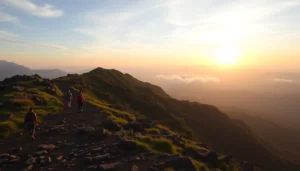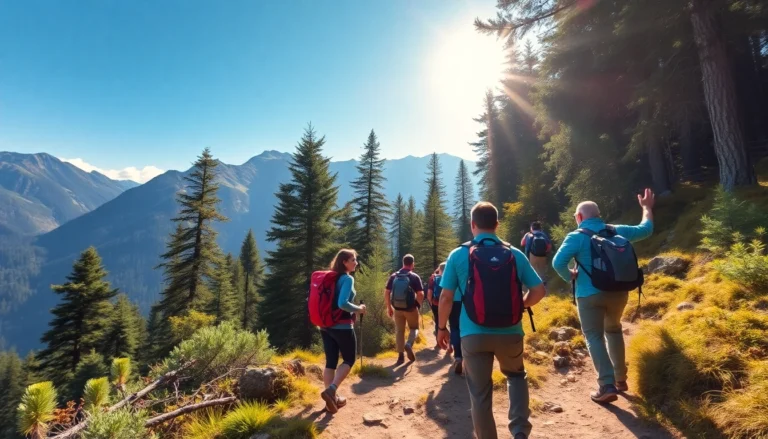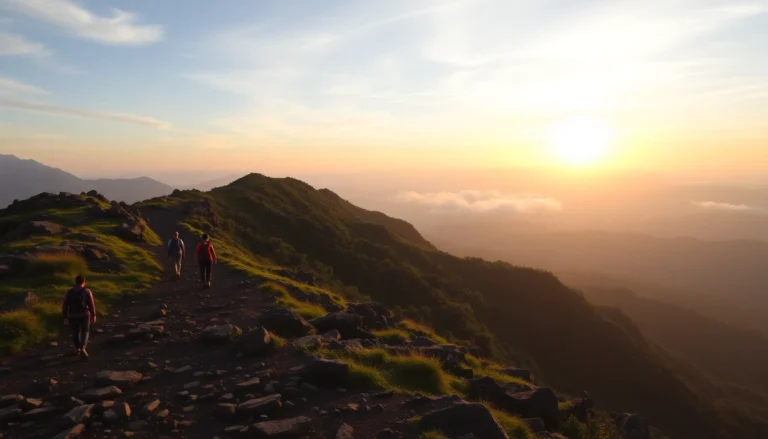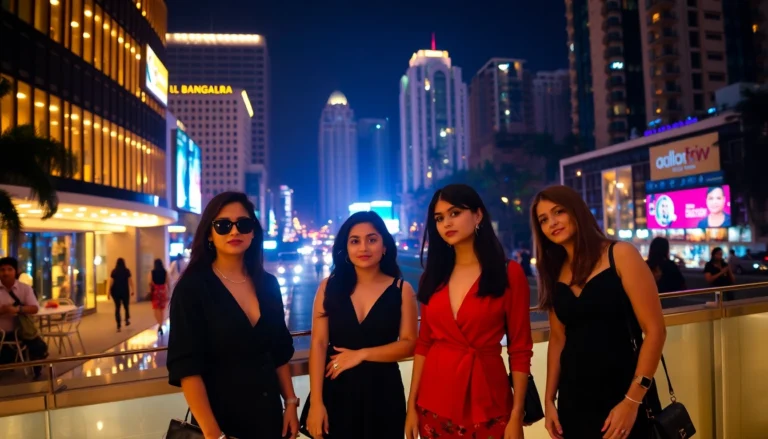Embarking on a guided trek offers a unique opportunity to explore some of Indonesia’s most breathtaking landscapes with the support of experienced guides who ensure safety, provide local insights, and enhance the overall adventure. For those seeking an immersive experience amid Indonesia’s diverse terrains—from active volcanoes to lush rainforests—understanding the essence of guided treks is crucial. If you’re considering an unforgettable journey, explore more about these adventures at guided trek and discover how to transform your travel experience into a safe, enriching exploration.
Understanding the Basics of a Guided Trek
What Defines a Guided Trek?
A guided trek is a meticulously organized journey primarily on foot, led by professional guides who are well-versed in the route’s terrain, history, and local culture. Unlike independent hiking, a guided trek offers structured support, ensuring participants navigate complex or remote environments safely. In Indonesia, guided treks often traverse volcanic slopes, dense jungles, and cultural villages, providing travelers with a comprehensive adventure that combines physical challenge with cultural immersion.
Guided treks are designed not only for adventure enthusiasts but also for beginners and families seeking safe yet exciting experiences. These journeys often include logistical support such as accommodations, meal arrangements, and safety measures, allowing trekkers to focus solely on the exploration and enjoyment of the surroundings.
Differences Between Hiking and Trekking
While these terms are sometimes used interchangeably, there are distinct differences—primarily in scope, effort, and duration. Hiking typically refers to a walk on well-marked trails, often shorter, recreational, and accessible to most people. Trekking, on the other hand, implies a longer, more challenging journey that often spans multiple days, demanding greater physical endurance and mental stamina.
In the Indonesian context, a simple day hike might involve walking through a protected forest or along a coastal trail, whereas a guided trek up Mount Rinjani or into remote jungle regions would require specialized guides, equipment, and logistical planning. Understanding these differences helps travelers choose the right experience based on their fitness levels and adventure goals.
The Role of a Trekking Guide
A trekking guide is much more than a navigational expert; they are the guardian of safety, cultural ambassador, and knowledge keeper. In Indonesia, guides bring to the table their extensive understanding of local ecosystems, histories, and traditions, enriching the trek with stories and insights. They are trained to handle emergencies, provide first aid, and adapt routes to prevailing weather conditions or participant needs.
Typically, a trekking guide’s responsibilities include route planning, assessing terrain difficulty, ensuring safety protocols, and facilitating interactions with local communities. Their expertise ensures that trekkers have an authentic experience without compromising safety or comfort. For example, navigating volcanic trails on Mount Rinjani requires specific knowledge about volcanic activity and altitude sickness prevention, which registered guides possess.
Planning Your Perfect Guided Trek in Indonesia
Choosing the Right Trekking Route
Indonesia’s diverse landscape offers a multitude of trekking options suitable for all preferences and fitness levels. When selecting a route, consider factors such as terrain difficulty, altitude, cultural interest, and seasonal weather patterns. For beginners, shorter jungle hikes or cultural walking tours in Bali or Lombok might be more appropriate, while seasoned trekkers may opt for multi-day climbs on Mount Rinjani or exploring the remote jungles of Sumatra.
Research your chosen destination thoroughly. Local operators can customize routes tailored to your interests, whether it’s wildlife observation, mountain climbing, or cultural interaction. For example, Rinjani’s trek to the crater lake offers panoramic views and volcanic terrains, best undertaken during the dry season from May to September for optimal safety and visibility.
What to Pack for a Guided Trek
Preparation is key to a successful trek. Essential gear includes sturdy hiking boots, layered clothing suitable for varying temperatures, rain gear, sun protection such as hats and sunscreen, a headlamp, and sufficient water bottles or hydration systems. Don’t forget a small first aid kit, insect repellent, energy snacks, and personal identification.
In addition, consider specialized gear if you plan to trek in high-altitude or glacier environments, such as trekking poles, thermal layers, or sleeping gear. Local guides often provide or recommend specific equipment based on the route’s requirements. Proper packing not only enhances comfort but significantly reduces the risk of injuries or health issues during the journey.
Best Seasons and Weather Considerations
Timing your trek during the optimal season is critical in Indonesia’s tropical climate. The dry season, typically from May to September, offers the best weather windows with less rain and clearer skies. Trekking during this period minimizes trail hazards, reduces risk of landslides, and ensures better visibility for scenic views and wildlife spotting.
Conversely, the rainy season from October to April can make trails muddy, slippery, and more challenging, although it also offers lush, vibrant landscapes and fewer crowds. If trekking during the rainy season, flexible scheduling and preparedness for weather changes are essential.
Top Destinations for Guided Treks in Lombok and Beyond
Mount Rinjani Treks with Expert Guides
Mount Rinjani, Indonesia’s second-highest volcano, is a premier trekking destination renowned for its spectacular crater lake, hot springs, and panoramic vistas. Guided Rinjani treks usually span 2 to 4 days, depending on the route chosen. Expert guides assist trekkers through volcanic terrains, lava fields, and cloud forests, offering insights into geological phenomena and local lore. Their knowledge ensures safety in this active volcanic environment, especially during periods of heightened activity.
Safety considerations include monitoring volcanic activity reports, acclimatization practices, and proper equipment. Many operators offer all-inclusive packages with porters, camping gear, and meals, allowing participants to focus on the adventure.
Jungle Treks and Cultural Trails
Indonesia’s rainforests and cultural villages provide unforgettable guided treks that blend natural beauty with authentic local experiences. For instance, trekking through Bali’s rainforest regions or Lombok’s Sumbawa, travelers encounter vibrant wildlife, waterfalls, and transitions into traditional villages. Guides often facilitate interactions with indigenous communities, offering insights into local crafts, customs, and histories.
Such treks promote sustainable tourism and cultural preservation, empowering local economies while delivering immersive experiences that foster appreciation and respect for indigenous ways of life.
Custom Guided Tours for All Fitness Levels
Whether you are an avid hiker or a casual explorer, tailored guided treks suit your fitness and interest levels. Many tour operators craft itineraries ranging from gentle nature walks suitable for families and seniors to strenuous multi-day mountain ascents for seasoned hikers. Customization includes route selection, camp vs. lodge accommodations, and special interests such as birdwatching or photography.
Working with local guides ensures flexibility and personalized attention, making the trek an enjoyable and accessible experience regardless of your background or physical condition.
Benefits of Booking a Guided Trek Organically and Safely
Access to Local Knowledge and Hidden Gems
Guides with deep understanding of the area unlock the stories behind each landscape and lead trekkers to lesser-known sights that are often inaccessible to solo travelers. From secret waterfalls in Lombok to endangered species habitats, guided treks reveal Indonesia’s hidden treasures and enrich the journey with historical and ecological context.
By trusting local expertise, travelers gain an authentic perspective that enhances both safety and cultural appreciation, creating memorable moments that go beyond typical tourist paths.
Ensuring Safety and Support in Remote Areas
Remote terrains, unpredictable weather, and active volcanic zones pose inherent risks. Professional guides are trained to mitigate these hazards through safety protocols, route assessments, and contingency planning. They carry essential safety equipment, coordinate rescue operations if necessary, and provide first aid support, ensuring peaceful exploration even in challenging environments.
Moreover, guided treks often include communication devices and emergency plans, which are invaluable in avoiding accidents and managing unforeseen circumstances.
Enhancing Your Adventure with Cultural Insights
Guides serve as cultural ambassadors, sharing local traditions, stories, and etiquette, thereby transforming a physical journey into a meaningful cultural exchange. Understanding local customs, participating in traditional ceremonies, and sampling authentic cuisine deepens the connection to the land and its people, making each trek not just an adventure but an educational experience.
How to Book and Prepare for Your Guided Trek Experience
Finding Reputable Tour Operators in Indonesia
Start your planning by researching established tour operators with verified reviews, certifications, and a commitment to sustainable tourism. Reputable companies provide detailed itineraries, transparent pricing, and experienced guides. For Indonesian treks, look for operators with expertise in the specific region you wish to explore, such as Lombok, Bali, or Sumatra.
Verify their safety records, client testimonials, and ecological practices. Many local operators collaborate with international agencies, ensuring adherence to safety standards and responsible tourism principles. Also, consider booking through platforms that allow for direct communication and customization of your adventure.
Preparation Tips for a Successful Trek
Beyond packing essential gear, preparation involves physical conditioning—regular walking, cardiovascular exercise, and strength training—especially for demanding routes like Rinjani. Acclimatize gradually to high altitudes and familiarize yourself with the route details and weather forecasts. Hydrate well, maintain a balanced diet, and arrive with a positive attitude and an open mind.
Consult your guides beforehand about specific requirements, health considerations, and safety protocols. Carrying a basic first aid kit, personal medications, and emergency contact information is also advised.
Post-Trek: Sharing Experiences and Feedback
After completing your trek, share your experiences with fellow travelers and the tour operators. Feedback helps improve services and supports sustainable tourism. Take photos, write reviews, and participate in community forums. In Indonesia’s vibrant tourism ecosystem, responsible sharing promotes awareness of local cultures and encourages future travelers to undertake guided treks responsibly.







